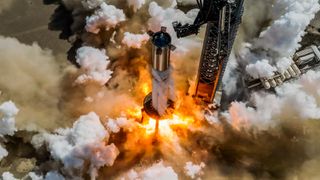
SpaceX just took another step toward the next launch of its Starship megarocket.
The company conducted a static fire test with its latest Super Heavy booster, the 33-engine Starship first stage, on Friday (April 5) at its Starbase site in South Texas.
SpaceX announced the milestone in two Friday posts on X, which shared photos and a video of the dramatically energetic test.
Related: Relive SpaceX Starship's 3rd flight test in breathtaking photos
Static fire of the Flight 4 Super Heavy booster pic.twitter.com/6KMgvKSmSKApril 6, 2024
Static fires, in which a rocket's engines are briefly ignited while the vehicle remains anchored to the ground, are common prelaunch tests. This particular Super Heavy is being prepped for the fourth-ever Starship launch, which is targeted for next month, according to SpaceX founder and CEO Elon Musk.
SpaceX has already performed static fires with the 165-foot-tall (50 meters) upper-stage spacecraft that will fly with this Super Heavy. Together, the duo will stand about 400 feet (122 m) tall.

Starship Die Cast Rocket Model Now $69.99 on Amazon.
If you can't see SpaceX's Starship in person, you can score a model of your own. Standing at 13.77 inches (35 cm), this is a 1:375 ratio of SpaceX's Starship as a desktop model. The materials here are alloy steel and it weighs just 225g.
Note: Stock is low so you'll have to act quickly to get this.
Starship's three previous test flights occurred in April 2023, November 2023 and March 14 of this year.
Get the Space.com Newsletter
Breaking space news, the latest updates on rocket launches, skywatching events and more!
The giant rocket's two stages failed to separate as planned on the debut flight, which ended after just four minutes. Starship achieved stage separation on flight two, and last month's mission made even more progress: It lasted nearly 50 minutes, and the Starship upper stage successfully opened and closed its payload door, among other milestones.
Starship is designed to be fully and rapidly reusable, the key breakthrough that Musk thinks will make settlement of Mars and the moon economically feasible. And moon missions are in the vehicle's future: NASA picked Starship to be the first crewed lander for its Artemis program of moon exploration. Current plans call for Starship to put astronauts down near the moon's south pole on the Artemis 3 mission in September 2026.
Join our Space Forums to keep talking space on the latest missions, night sky and more! And if you have a news tip, correction or comment, let us know at: community@space.com.

Michael Wall is a Senior Space Writer with Space.com and joined the team in 2010. He primarily covers exoplanets, spaceflight and military space, but has been known to dabble in the space art beat. His book about the search for alien life, "Out There," was published on Nov. 13, 2018. Before becoming a science writer, Michael worked as a herpetologist and wildlife biologist. He has a Ph.D. in evolutionary biology from the University of Sydney, Australia, a bachelor's degree from the University of Arizona, and a graduate certificate in science writing from the University of California, Santa Cruz. To find out what his latest project is, you can follow Michael on Twitter.

